Duke Energy Corporation (DUK) is a utility company operating through two broad segments: Electric Utilities and Infrastructure (EU&I) and Gas Utilities and Infrastructure (GU&I). The company distributes electricity and natural gas.
The company has announced multiple divestitures this year. In July, DUK said that it would sell its commercial distributed generation business to private equity firm ArcLight Capital Partners. A month prior, the company announced the sale of its unregulated utility-scale Commercial Renewables business to Brookfield Renewable.
Moreover, the stock is trading at a premium compared to its industry peers, indicating a stretched valuation. In terms of forward EV/Sales, it is trading at 5.43x, 49.5% higher than the industry average of 3.63x. Its forward Price/Sales multiple of 2.54 is 31.5% higher than the 1.93 industry average.
Given this backdrop, let’s look at the trends of DUK’s key financial metrics to understand why it could be wise to avoid the stock now.
Analyzing Duke Energy Corporation's Financial Performance from 2020 to 2023
DUK's trailing-12-month net income exhibited an overall growth trend from September 2020 to September 2022 and observed a significant drop from December 2022 onwards. Here is the detailed breakdown:
- In September 2020, the net income stood at $2.14 billion.
- Through 2020, net income fluctuated, diminishing to $1.38 billion in December 2020.
- The first half of 2021 witnessed a slight increase, with the net income reaching $2.10 billion in June 2021.
- A substantial uptick was seen in the latter half of the year as the figure escalated to $3.90 billion by December 2021.
- Maintaining the momentum, net income slightly reached $3.93 billion by September 2022.
- However, a drastic drop was observed after this point. The income plummeted to $2.55 billion by December 2022 and further descended to $1.37 billion by June 2023.
Over the discussed timeline, DUK's net income demonstrated a net growth of approximately 36% from $2.14 billion in 2020 to $2.92 billion in 2023, measured by comparing the first value to the last. Yet, it is significant to note that despite this overall growth, the company has been experiencing a substantial downward trend in its net income from the end of 2022 till mid-2023.
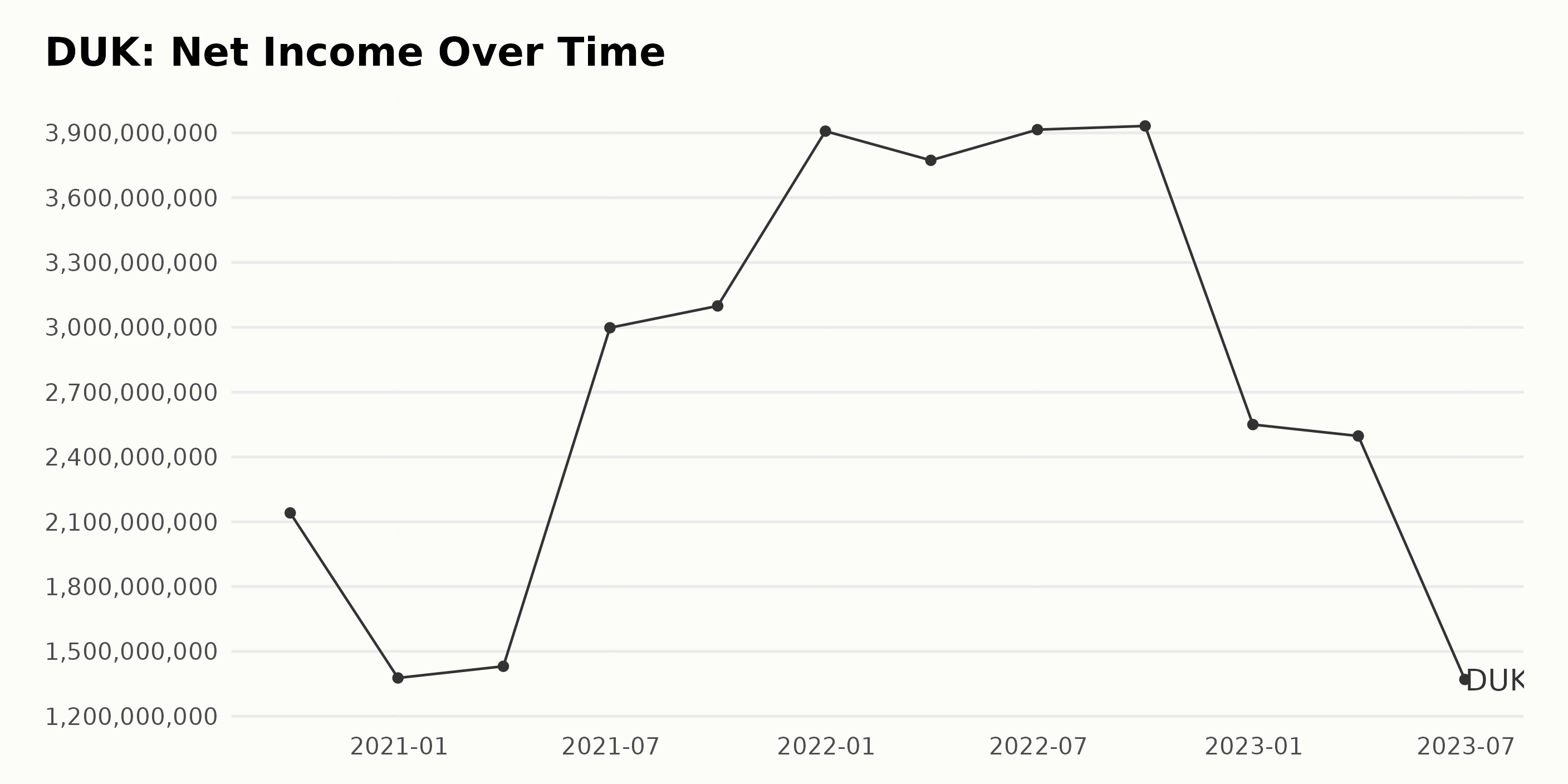
The gross margin of DUK showed a fairly consistent trend over the timeframe, with a few notable fluctuations.
- On September 30, 2020, DUK's gross margin was at 42.6%.
- An increase was observed on December 31, 2020, bringing the gross margin to 42.9%.
- The gross margin dropped slightly to 42.7% by March 31, 2021.
- From June 30, 2021, to December 31, 2021, the gross margin remained steady at 42.9% initially before dropping to 42.7%.
- Beginning in 2022, we observed an irregular downward slope starting from a gross margin of 41.6% on March 31, dropping to 40.0% by December 31 of the same year.
- In 2023, there was a marginal increase noticed where the gross margin rose from 40.1% on March 31 to 40.4% by June 30, 2023.
Over the series, the gross margin decreased by 5.2% between the initial point on September 30, 2020, and the endpoint on June 30, 2023. Emphasis on recent data shows that there has been a decline in the gross margin throughout 2022 before showing a small recovery in the first half of 2023.
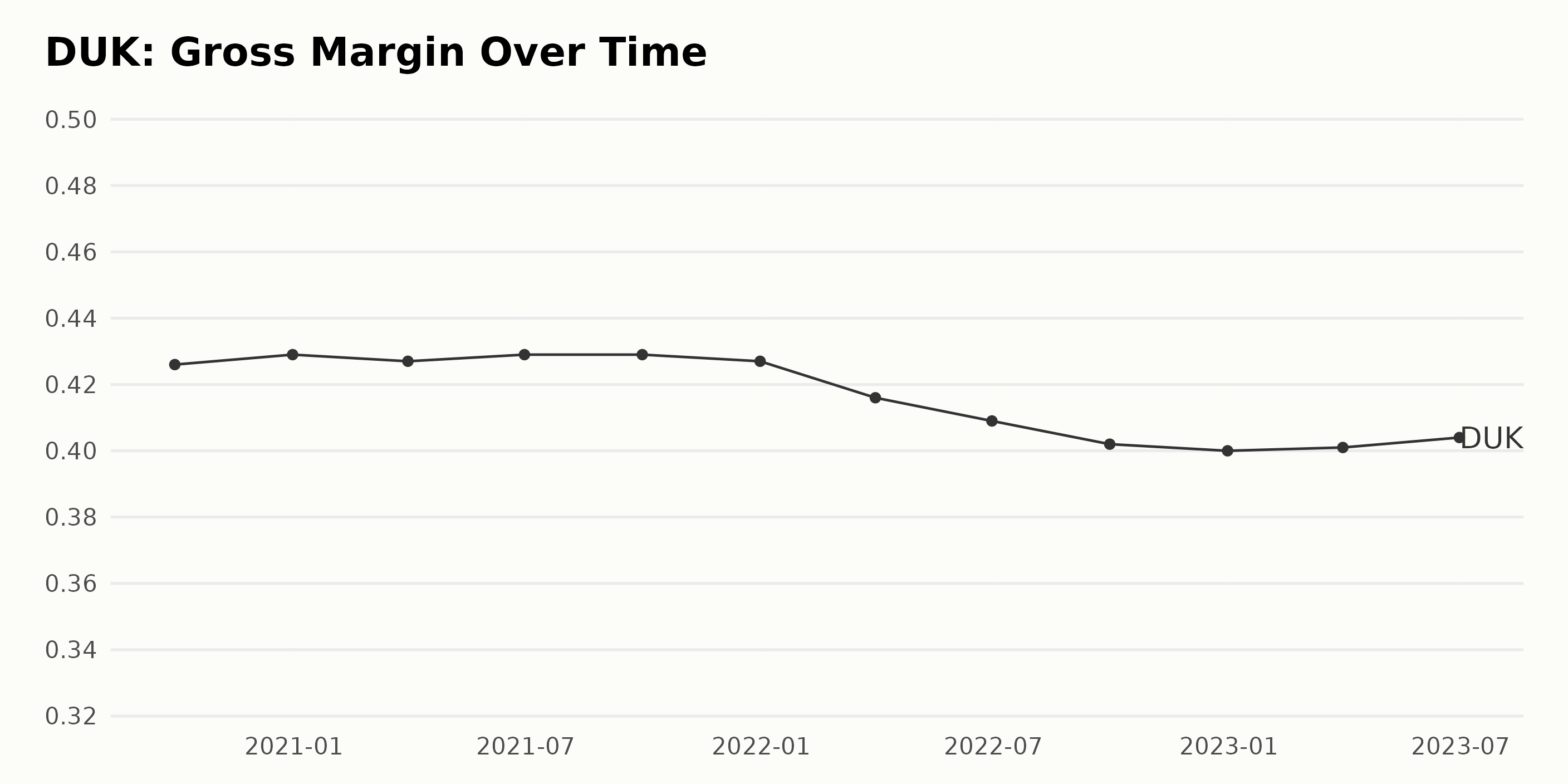
Return On Sales (ROS) Data Summary:
- On September 30, 2020, DUK recorded a ROS of 0.18.
- There was a notable decrease by the end of 2020, with a ROS of 0.14 on December 31.
- In the first quarter of 2021, the ROS slightly decreased to 0.14 before a significant increase to 0.21 in the second quarter.
- By September 30, 2021, the ROS had increased slightly to 0.22.
- Moving into 2022, there was a slight increase to a peak of 0.25 by the year-end.
- The value then trended downwards over 2022 with some fluctuations, hitting 0.23 by September 30 and ending with a decrease to 0.18 by December 31.
- The first half of 2023 saw a stabilization of the ROS, with March seeing a value of 0.19 and a decline to 0.16 by June 30, 2023.
Growth Comparison:
- Comparing the first and last values of the series, there has been a decrease from 0.18 in September 2020 to 0.16 in June 2023.
- This suggests a negative growth in terms of ROS when measured over this period.
Overall Trend:
- The overall trend for DUK’s ROS shows some fluctuations over the analyzed period.
- It experienced rises and falls, with noticeable peaks in mid-2021 and late 2022, followed by subsequent decreases.
- Emphasis on recent data reveals a declining trend as we move from a peak at the end of 2022 to reduced values in the first half of 2023. The last value in the data series for DUK's ROS, as recorded on June 30, 2023, is 0.16.
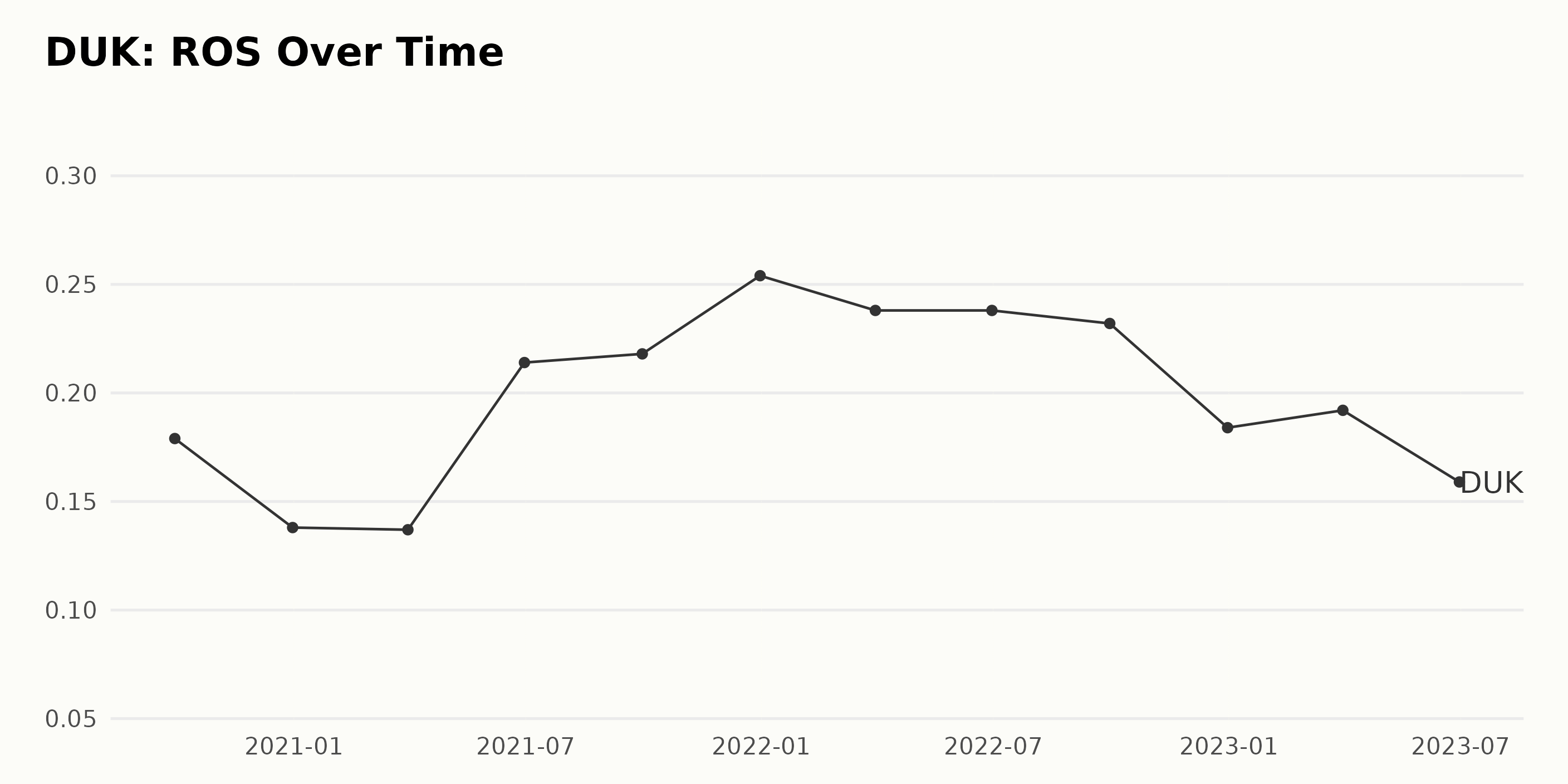
The following observations can be made on the provided series of the analyst price target of DUK:
- The report starts with a price target of $106 in November 2021. This value remained fairly constant, with minor fluctuations until the end of December 2021.
- A gradual increase in the price target was observed in the first quarter of 2022, culminating at $120 in April 2022.
- This was followed by a slight decline and then stability around $118 through to September 2022. It saw a dip in October 2022, touching down to $108.
- In late 2022 and early 2023, it experienced a slight recovery, reaching up to $111 in February 2023. After that, it again declined with some fluctuations and stabilized around $110 until June 2023.
- Afterwards, a sharp decline was noticed, hitting as low as $103.4 in June 2023.
- From July 2023, the price target began to stabilize again, fluctuating around $102-$103 up toward the end of August 2023.
- In September 2023, another slight downfall was observed, ending at $101.
Overall, over the reported period from November 2021 to September 2023, the analyst price target for DUK showed a decrease of about -4.72%. Recent data shows a trend of decline from the peak of $120 in April 2022.
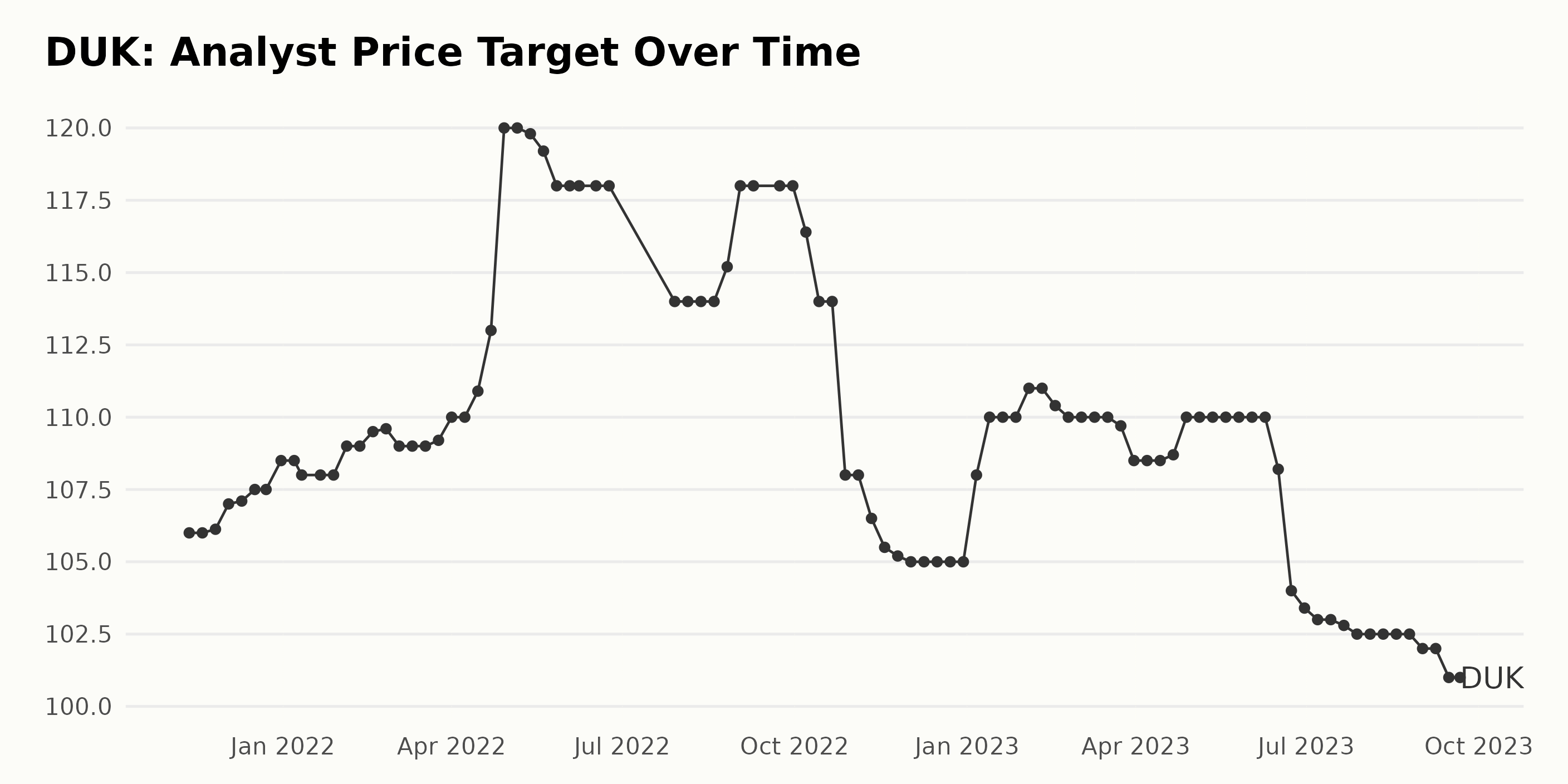
Analyzing Duke Energy Corporation's Stock Price Fluctuations: March-September 2023
Based on the data provided, the trend of DUK share price from March to September 2023 experienced several fluctuations. Here are the key observations made from the analyzed data:
- Starting at a stock price of $95.73 in March 2023, DUK shares witnessed an overall upward trend through the end of April 2023, reaching $99.05, with very slight up-down movements.
- In May 2023, the price significantly decreased from $98.35 at the beginning of the month to $90.19 by the end of May.
- In June 2023, the share prices started slightly low at $88.73, peaked around mid-June at $91.40, and then fell again to $89.75 by the end of June.
- Between July and August 2023, the stock price steadily rebounded, hitting a peak at $94.73 toward the end of July before falling once again to $90.06 at the end of August.
- In September 2023, the share price dipped as low as $88.48 before bouncing back considerably, reaching $94.37 by September 20.
In conclusion, DUK's growth rate during this period is inconsistent. The share price showed periods of both acceleration and deceleration, demonstrating a lack of a stable growth pattern. Here is a chart of DUK's price over the past 180 days.
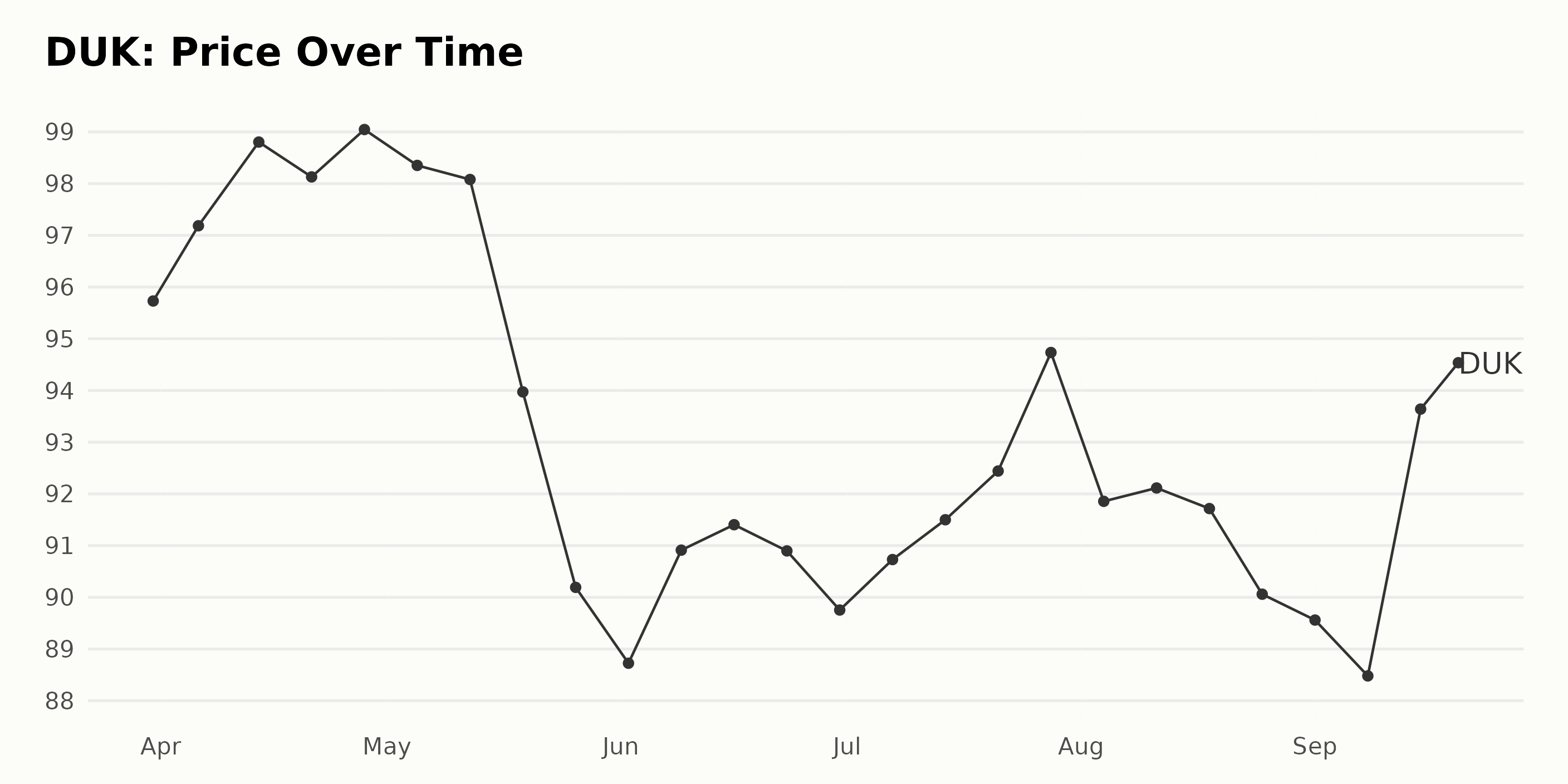
Analyzing Momentum, Stability, and Growth Dimensions for Duke Energy Corporation
The POWR Ratings grade for DUK, a stock in the Utilities - Domestic category, shows some fluctuations when broken down weekly. Notably, in the period ranging from March 25, 2023, to September 21, 2023, the POWR grade remains consistent at C (Neutral) until a shift observed around mid-September wherein it changes to D (Sell).
However, there is notable volatility in its rank within the category. Below are some specifics that can be seen from the data:
- The POWR Grade for DUK maintains a C (Neutral) grade consistently from March 25, 2023, through September 9, 2023.
- Starting from September 9, 2023, the POWR Grade for DUK drops to a D (Sell) grade and sustains it till the latest recorded date.
- In terms of ranking within its category, during this period, DUK started from a superior rank (#14) in late March and reached as low as #46 toward the end of the recorded data.
- The latest provided rank in the category as of September 21, 2023, is #46, marking a decline in its superiority among other stocks in the Utilities - Domestic category.
Therefore, according to this data, the latest POWR Grade for DUK as of September 21, 2023, is D (Sell). Its rank in the category of Utilities - Domestic stocks is #46 out of a total of 65 stocks. This indicates that DUK's position within its category has been decreasing over this period.
For DUK, the three most noteworthy dimensions based on POWR Ratings are Momentum, Stability, and Growth.
Momentum:
- As of March 2023, the Momentum dimension held a high rating of 88.
- It observed a slight decrease in April 2023 to 86 and continued this downward trend for succeeding months. By September 2023, it dropped to 40.
Stability:
- For DUK, the Stability reading started at 82 in March 2023.
- Despite slight variations in the ensuing months, the scores remained relatively high, with the last recorded standing at 76 as of September 2023.
Growth:
- Initially, in March 2023, the growth dimension achieved a rating of 82.
- However, a sharp decline was observed over the following months, falling to 31 by July 2023. By September, a negligible rise to 32 was observed.
It's important to note that while Momentum and Stability have relatively high ratings, Growth saw a clear downtrend over the observed period.

How does Duke Energy Corporation (DUK) Stack Up Against its Peers?
Other stocks in the Utilities - Domestic sector that may be worth considering are Genie Energy Ltd. (GNE), Vistra Corp. (VST), and Brookfield Infrastructure Corporation (BIPC) - they have better POWR Ratings. Click here to explore more stocks in the Utilities – Domestic sector.
43 Year Investment Pro Shares Top Picks
Steve Reitmeister is best known for his timely market outlooks & unique trading plans to stay on the right side of the market action. Click below to get his latest insights…
Steve Reitmeister’s Trading Plan & Top Picks >
DUK shares were trading at $94.12 per share on Thursday afternoon, down $0.25 (-0.26%). Year-to-date, DUK has declined -5.68%, versus a 14.93% rise in the benchmark S&P 500 index during the same period.
About the Author: Anushka Dutta

Anushka is an analyst whose interest in understanding the impact of broader economic changes on financial markets motivated her to pursue a career in investment research.
The post Should Investors Buy or Sell Duke Energy (DUK) Stock This Week? appeared first on StockNews.com
